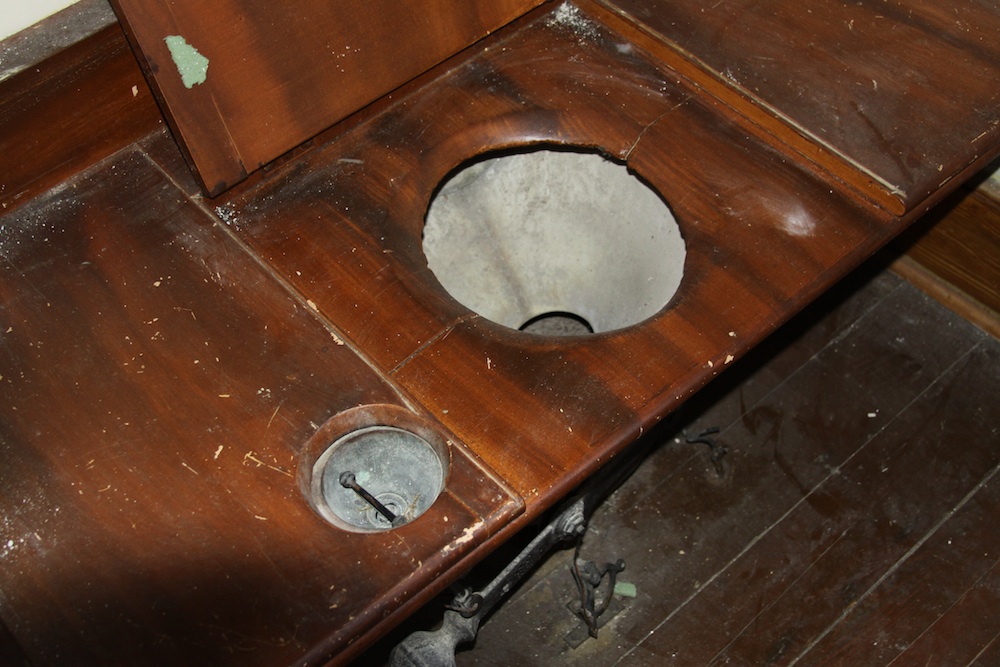Flushed with Pride: 1850s Bathroom Boasts Early Plumbing Technology

In 1850s America, most people relied on privies and outhouses for their bathroom needs. But the Davis family of Natchez, Miss., had something few other Americans did: indoor hot-and-cold running water and an indoor toilet.
Now this marvel of 19th-century technology is getting a new home, moving from the Dunleith Historical Inn to another mansion nearby operated by the National Park Service. The new lodging will give the public a chance to see a pre-Civil War version of a luxurious lavatory, complete with shower/bath combo.
"This is a rare example of a mid-19th-century bathroom that had survived for 150 years," said National Park Service historian Jeff Mansell.
Most 1800s bathrooms have been renovated out of existence, Mansell said — and few families had indoor plumbing at the time, anyway. The White House only got running water in 1833, for example, and it wasn't until 1853 that the presidential family got running water in their second-floor washroom. [See Photos of 1850s Bathroom]
The best bathroom technology
The Dunleith bathroom consists of a washbasin with two faucets, a toilet and an L-shaped tub-and-bathtub combination, also with two faucets. Pipes pumped water up from the first-floor laundry room, where water was heated, Mansell said. The pipes led to three cisterns in the attic, which drained down to fixtures in the third-floor bathroom whenever someone opened the faucets or flushed the toilet. Waste from the toilet would have gone to a primitive septic system, Mansell said, joining waste from outdoor privies on the property.
The oval-shaped showerhead was large, about 10 inches (25 centimeters) across and would have created a rainfall effect, much like showerheads in upscale bathrooms today.
Get the world’s most fascinating discoveries delivered straight to your inbox.
"In the 19th century, you had what everybody's trying for today, the rain shower," Mansell said.
A man named Alfred Vidal Davis, who, in 1859, bought the house that would become the Dunleith Inn, most likely installed the bathroom the year he moved in, Mansell said. When the preservation team was deconstructing the bathroom to remove it from its third-floor location, they found a packing slip from a New Orleans retailer called Price & Coulon, he said.
"Davis could have seen it there or may have read about it," Mansell said. "We think there was a catalog that was advertising this particular system."
National Park staff isn't sure how much the system would have cost Davis, but indoor plumbing would have been a privilege reserved for the elite.
The future of the Dunleith bathroom
The Dunleith Historical Inn decided to donate the fixtures to the National Park Service because they are renovating the wing where the bathroom was. The bathroom was at the top of a steep stairwell, said Dunleith general manager John Holyoak, and because of its inaccessibility had been used for storage for the past 10 years.
"It's just not conducive for anybody to ever see the bathroom," Holyoak said.
To get the fixtures, including a 400-pound zinc-lined cistern, down from the third floor and attic, construction crews had to build a specially designed ramp. For now, the disassembled bathroom is in storage, but the National Park Service plans to reinstall them in the nearby estate of Melrose, another wealthy home from the same era. Historians know that Melrose had some sort of washroom in the 1850s, but they aren't sure whether it was as elaborate as the Dunleith one.
"There's some indication that they had had some sort of indoor plumbing system, but it was removed right after the turn of the century," Mansell said. "So we don't know what it looked like."
Soon, however, visitors will be able to see with their own eyes the private perks of pre-Civil War wealth.
"Most people, when they think of the mid-19th century, they don't think of this kind of technology existing," Mansell said. "Even as sophisticated as Natchez was, with people here with a lot of money, you didn't find a lot of indoor plumbing."
You can follow LiveScience senior writer Stephanie Pappas on Twitter @sipappas. Follow LiveScience for the latest in science news and discoveries on Twitter @livescience and on Facebook.

Stephanie Pappas is a contributing writer for Live Science, covering topics ranging from geoscience to archaeology to the human brain and behavior. She was previously a senior writer for Live Science but is now a freelancer based in Denver, Colorado, and regularly contributes to Scientific American and The Monitor, the monthly magazine of the American Psychological Association. Stephanie received a bachelor's degree in psychology from the University of South Carolina and a graduate certificate in science communication from the University of California, Santa Cruz.
 Live Science Plus
Live Science Plus





